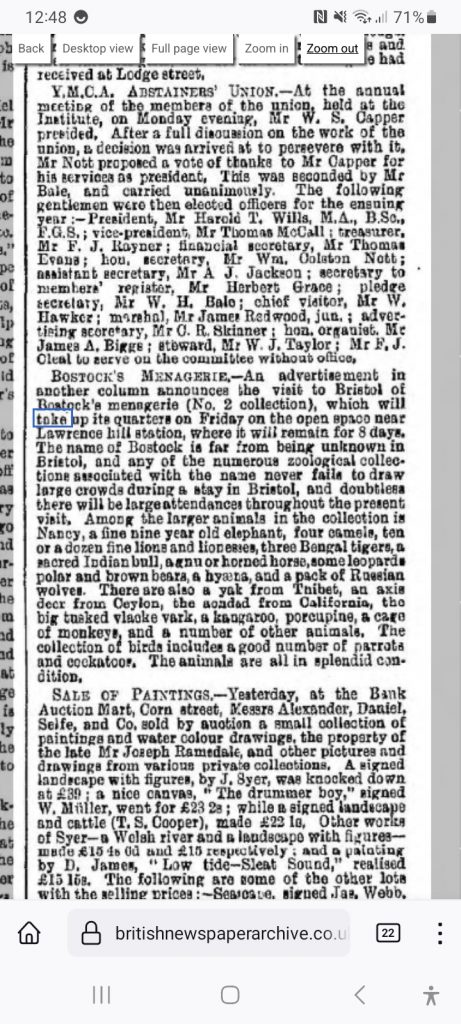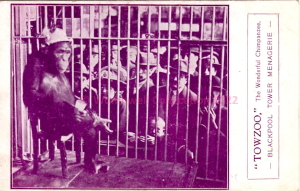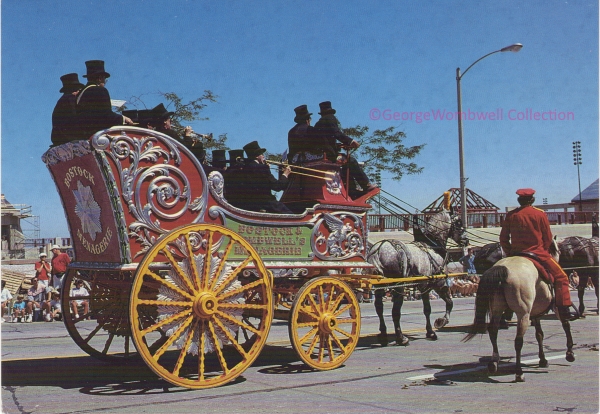Verso:
‘on Great North Road 1903’
‘McAlpine’
Pencil: ‘Noble Horse’


Verso:
‘on Great North Road 1903’
‘McAlpine’
Pencil: ‘Noble Horse’


On show at the Circus Hall of Fame Sarsota, Florid, USA.
Edward Cross, a notable wild beast merchant of the 19th century, owned and operated the menagerie at Exeter Exchange in London. Among his collection of exotic animals were several lions, and he famously named multiple lions “Wallace.”
Number of Wallace Lions:
It is documented that there were at least three lions named Wallace at different times. Each of these lions gained some degree of fame:
The practice of reusing the name “Wallace” for successive lions helped build a lasting brand and reputation for Cross’s menagerie, attracting visitors who were familiar with the famed lion by that name. This tradition of naming multiple animals with the same name is not uncommon in the history of menageries and zoos.
George Wombwell was a prominent British showman and the founder of Wombwell’s Traveling Menagerie, one of the most famous traveling animal shows in the 19th century. His menagerie was renowned for its exotic animals, and among them, a lion named Wallace became particularly famous.
Fame and Legacy:
George Wombwell’s lion, Wallace, remains one of the most famous lions in the history of traveling menageries. Wallace’s reputation for being a magnificent and gentle lion made him a star attraction and helped cement George Wombwell’s legacy as a leading showman of his time. The story of Wallace highlights the public’s enduring fascination with exotic animals and the rich history of animal exhibitions in the 19th century.
However, the Wallace depicted above was from the USA, and, according to the card, was from the Wombwell and Bostock Wold Animal Show. Reported to have killed 3 of its trainers and had to be ‘executed’.
It was Frank Bostock that went to the USA in the late 1800s and successfully traveled the country with his Wild Animal Show. He also had a permanent site on Coney Island, New York.
Frank C. Bostock, known as the “Animal King,” was a pioneering figure in the world of traveling menageries and animal shows. Originating from a family deeply entrenched in the circus and menagerie business in the UK, Bostock expanded his operations internationally, achieving remarkable success in New York in the late 19th and early 20th centuries.
Born in 1866 in England, Frank Bostock was part of the famous Bostock and Wombwell menagerie family. From a young age, he was immersed in the world of exotic animals and show business. Frank eventually branched out to create his own menagerie, distinct from his family’s legacy, which would go on to become a global sensation.
In the early 1890s, Frank Bostock brought his menagerie to the United States, where he quickly made a name for himself. New York, with its burgeoning entertainment industry and appetite for spectacle, provided the perfect setting for Bostock’s grand exhibitions.
Frank Bostock’s tenure in New York marked a significant chapter in the history of traveling menageries and animal exhibitions. Through his innovative approach to animal training and showmanship, Bostock captivated audiences and set new standards for the industry. His legacy as the “Animal King” endures, reflecting his contributions to entertainment, animal welfare, and cultural history.

Wessex Archaelogy are to look for a dead elephant near Kingswood, Bristol. Here’s The Observer link to the report.
I have doubts they will find much other than bones. Bones with lots of ‘hacks’ on them. At £400 a time the late Victorian menagerist, EH Bostock (or in this case his brother in law Frank Bostock (Little Frank*)), would have extracted as much of the meat from the bones to feed to the other beasts in the menagerie.
However, if they do find anything of the elephant, then the forensics would be interesting. The pit would, of course be large and easy to spot methinks!
Psst! There’s an elephant buried on the banks of The Clyde River. Don’t tell anyone.
There’s one buried at Smithfields market too!
*Not to be confused with E H’s brother Frank (Big Frank)
hattip to Heather for these reliable facts.
An rare monochrome photograph and a monochrome postcard have been added to the archive.

Date unknown, but the menagerie is utilising electric lights. Verso states the menageire was sold at Newcastle.

The photographic angle of the second image is interesting: Who’s looking at who!
Recent addition to the collection is this 1929 programme for the annual Nottingham Goose Fair, still taking place in the centre of the city. It includes the layout of the fair and it strikes me that B&W are still the biggest attaction, with their pitch taking up a considerable section of the square. This was one of the last fairs that B&W attended before their demise in the early thirties.

A Grand Bostock and Wombwell bandwagon in USA parade at Circus World Museum, Wisconsin where many Victorian Menagerie items are on display/stored. Any B&W items were probably from Frank Bostock’s collection.
Colour printed postcard, verso: This elegant vehicle dates back to 1882 England. A remarkable feature of this wagon are the six-foot diameter rear wheels. The Wombwell name dates back to 1805 when it was used on a travelling menageire. Photo:Jim Morrill
Bostock and Wombwell’s claimed at several times in their history, to possess the smallest horse in the world. Indeed, several competitors made the same claims to draw crowds to their booths.
Where Bostock succeeded was in not quite telling the truth. In this card they show the ‘smallest horse in the world’, but closer examination of the photo-printed card, reveals it is a composite of two photographs. Doctoring photographs for financial gain, is not a new phenomenon and showmen were ‘at it’ here in 1911 (used card, franked Jul 24 11). I doubt anyway, that a horse and a dog would stand still in that position long enough to have their portraits taken!

Pointed out to me by Terence Ruffle, I think this is well written and quite sad. Possibly not for the animals, but who really knows what they are thinking? The ‘ Greatest Show on Earth’ comes to an end in May 2017. Quite tearful. TJ would be quite angry and George Wombwell the World’s Greatest Showman, George Wombwell would be very sad, and probably wondering how he could capitalise on Barnham’s demise!

A 14-year-old girl named Zazel was the first to be shot out of a cannon, in 1877 London.
On the subject of old ‘trains’, I often wonder if there are any of the caravans that Bostock and Wombwell travelled in, languishing somewhere in a farm outbuilding in the UK? It would make a really good project to refurbish one of them, provide young people with skills training, etc. If anyone knows of one please let us know. Where to look? Farm barns, fields, zoos (Whipsnade, etc.), railyards…
The information age has surely killed live perfomances. Young people will never know what it was like to see tigers and lions,etc.


It has been brought to my attention that there will be a feature concerning the Bostock and Wombwell families on The Antiques Roadshow on Sunday 4th September 2016 at 20.00 hours British Summer Time. Heather Payne, E.H. Bostock’s granddaughter, will be ‘grilled’ by the expert and show some of her collection of memorabilia. Worth setting the recorder for that one! Well done Heather for promoting the family business.
PS: I have had a conversation with a curator at the Saffron Walden Museum and they are very interested in the new book. If only they could tell us exactly where George was born!
UPDATE2: It was produced by the ‘Warwick Trading Company’ and BFI has many of their films.
UPDATE: Just noticed the 1911 date on the film.
I discovered this old film on YouTube. It seems to show the end of an elephant to include its funeral pyre. It has German titles and has been translated as ‘Lights and Shades on the Bostock Circus Farm’. As well as an elephant and a bear performing, the participants are aslo acting throughout the film. I would like to think this film is nothing to do with the Bostock and Wombwell outfit, but I know nothing else on the film. It has a permanent logo showing BFI which is the British Film Institute. I will be contacting them to get a history of the film, but if anyone can shed light then let me know. I wonder if it is a travelling outfit on the continent around the 1920s/30s? The keepers do not seem to be very kind to their animals. Was it a Nazi propaganda stunt? Anything is possible.